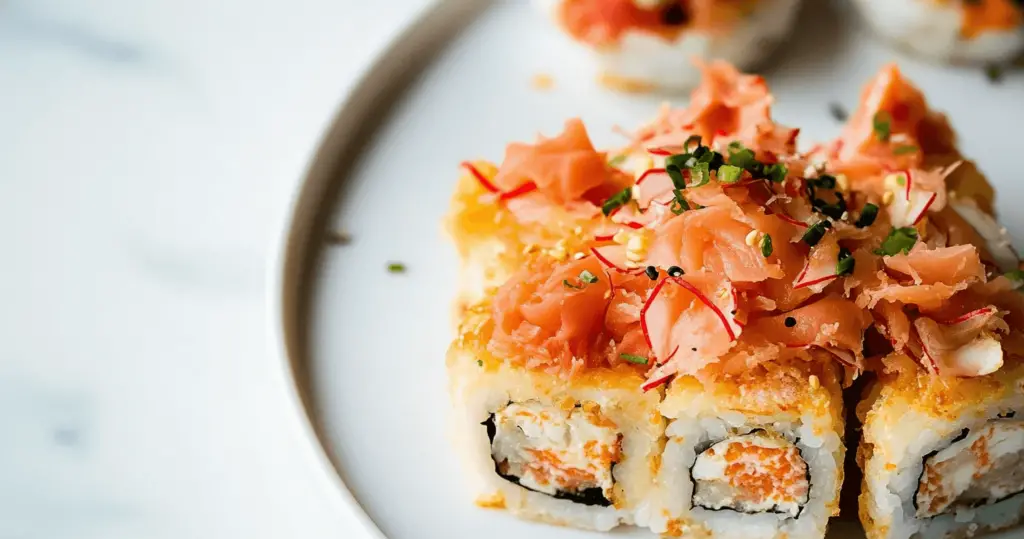Sushi pizza is a creative and delicious fusion dish that combines the best elements of sushi and pizza into one unique culinary experience. This dish features a crispy rice base topped with fresh fish, vegetables, and a variety of flavorful sauces, creating a delightful contrast of textures and flavors. Whether you’re a sushi lover or a pizza enthusiast, sushi pizza is a must-try dish that will impress your taste buds and your guests.

Overview of Sushi Pizza
Sushi pizza typically consists of a base made from sushi rice that is shaped and fried to resemble a pizza crust. This crispy rice base is then topped with traditional sushi ingredients such as raw or cooked fish, avocado, cucumber, and drizzled with sauces like spicy mayo, eel sauce, or soy sauce. The result is a visually stunning and mouthwatering dish that combines the savory elements of sushi with the satisfying crunch of a pizza crust.
Brief History and Cultural Significance
Sushi pizza is a relatively new invention, believed to have originated in North America as part of the broader trend of sushi fusion cuisine. It reflects the creative and experimental spirit of modern culinary arts, where chefs blend different culinary traditions to create innovative dishes. The popularity of sushi pizza has grown rapidly, especially in cities with vibrant food scenes and a penchant for fusion cuisine. It represents the cultural exchange and culinary evolution that continues to shape contemporary gastronomy.
Preparation Phase & Tools to Use
Making sushi pizza requires some preparation and the right tools to ensure success. Here are the key elements you need to know:
- Prep Time: 20 minutes
- Cook Time: 10 minutes
- Cool Time: 10 minutes
- Total Time: 40 minutes
- Servings: 4 servings
- Yield: One 10-inch sushi pizza
Essential Tools and Equipment
To make sushi pizza, you will need the following tools and equipment:
- Mixing Bowls: For preparing and mixing ingredients.
- Rice Cooker: For perfectly cooked sushi rice.
- Baking Sheet: For shaping and baking the rice base.
- Plastic Wrap: To help shape the rice without sticking.
- Sharp Knife: For slicing fish and vegetables.
- Spatula: For spreading ingredients evenly.
- Frying Pan: If you choose to fry the rice base for extra crispiness.
Each of these tools plays a crucial role in the preparation of sushi pizza, ensuring that the process is smooth and the end result is a perfectly crafted dish.
Importance of Each Tool
Mixing Bowls: These are essential for mixing and holding ingredients during preparation. Use different sizes for various ingredients to keep everything organized.
Rice Cooker: Ensures the sushi rice is cooked to perfection. Consistently cooked rice is crucial for the structure and texture of the sushi pizza base.
Baking Sheet: Used for shaping and possibly baking the rice base. A flat, even surface helps achieve the desired pizza shape.
Plastic Wrap: Helps in shaping the rice base without sticking to your hands or the surface.
Sharp Knife: A high-quality, sharp knife is essential for slicing raw fish and vegetables with precision.
Spatula: Useful for spreading and layering ingredients evenly across the rice base.
Frying Pan: If you prefer a crispier base, a frying pan is essential for frying the rice to a golden brown.
Preparation Tips
To ensure your sushi pizza turns out perfectly, consider these tips:
- Rinse the Rice: Rinse sushi rice thoroughly until the water runs clear to remove excess starch and achieve the best texture.
- Season the Rice: Properly season the rice with rice vinegar, sugar, and salt while it’s still warm for optimal flavor.
- Shape the Rice: Use plastic wrap to help shape the rice into a uniform, flat pizza base. This prevents sticking and helps achieve a consistent thickness.
- Cool the Rice Base: Allow the rice base to cool before adding toppings to prevent the ingredients from becoming too warm or soggy.
- Use Fresh Ingredients: Fresh, high-quality fish and vegetables make a significant difference in the taste and presentation of your sushi pizza.
- Customize Toppings: Feel free to experiment with different toppings and sauces to suit your taste preferences.
Ingredients List
- 2 cups sushi rice
- 2 1/2 cups water (for cooking the rice)
- 1/4 cup rice vinegar
- 2 tablespoons sugar
- 1 teaspoon salt
- 1 tablespoon vegetable oil (for frying)
- 8 ounces sushi-grade fish (such as salmon or tuna)
- 1 avocado, sliced
- 1/2 cucumber, julienned
- 1/4 cup spicy mayo (store-bought or homemade)
- 2 tablespoons eel sauce (optional)
- 2 tablespoons soy sauce
- 1 teaspoon sesame seeds
- 1 tablespoon finely chopped green onions
- Nori strips (optional, for garnish)
Step-by-Step Instructions
- Cook the Rice: Rinse the sushi rice until the water runs clear. Add the rice and water to a rice cooker and cook according to the manufacturer’s instructions. Once cooked, transfer the rice to a large mixing bowl.
- Season the Rice: While the rice is still warm, mix in the rice vinegar, sugar, and salt. Stir gently to combine, ensuring the seasoning is evenly distributed. Allow the rice to cool to room temperature.
- Shape the Rice Base: Line a baking sheet with plastic wrap. Transfer the seasoned rice to the baking sheet and spread it out evenly to form a round, flat pizza crust about 10 inches in diameter.
- Fry the Rice Base (Optional): For a crispier base, heat vegetable oil in a large frying pan over medium-high heat. Carefully transfer the rice base to the pan and fry for 3-5 minutes on each side until golden brown. Transfer back to the baking sheet and allow to cool.
- Prepare the Toppings: Slice the sushi-grade fish into thin pieces. Slice the avocado and julienne the cucumber.
- Assemble the Sushi Pizza: Once the rice base has cooled, spread a thin layer of spicy mayo over the top. Arrange the sliced fish, avocado, and cucumber evenly over the rice base. Drizzle with eel sauce and soy sauce if using.
- Garnish: Sprinkle sesame seeds and finely chopped green onions over the top. Add nori strips if desired.
- Serve: Cut the sushi pizza into slices using a sharp knife and serve immediately.
Variations and Flavor Profiles
While the classic sushi pizza is delightful on its own, experimenting with different variations can add excitement and diversity to your culinary repertoire. Here are some popular variations and their flavor profiles:
Classic Sushi Pizza
- Ingredients: Sushi rice base, sushi-grade fish, avocado, cucumber, spicy mayo, eel sauce, soy sauce, sesame seeds, green onions, nori strips
- Flavor Profile: Balanced with the freshness of the fish, creaminess of the avocado, and the tanginess of the spicy mayo and eel sauce.
Spicy Tuna Sushi Pizza
- Ingredients: Sushi rice base, spicy tuna mix (diced tuna, spicy mayo, sriracha), avocado, cucumber, tobiko (flying fish roe), soy sauce, sesame seeds
- Flavor Profile: Spicy and savory with the richness of tuna, the heat of sriracha, and the crisp freshness of cucumber and avocado.
Vegetarian Sushi Pizza
- Ingredients: Sushi rice base, avocado, cucumber, carrot, bell pepper, radish, spicy mayo, soy sauce, sesame seeds, microgreens
- Flavor Profile: Fresh and crunchy with a variety of vegetables, complemented by the creamy and spicy notes of the mayo.
Salmon and Avocado Sushi Pizza
- Ingredients: Sushi rice base, thinly sliced salmon, avocado, cucumber, pickled ginger, soy sauce, wasabi mayo, sesame seeds, green onions
- Flavor Profile: A harmonious blend of buttery salmon, creamy avocado, and the sharpness of pickled ginger and wasabi mayo.
Tempura Shrimp Sushi Pizza
- Ingredients: Sushi rice base, tempura shrimp, avocado, cucumber, spicy mayo, eel sauce, soy sauce, sesame seeds, green onions
- Flavor Profile: Crunchy and savory with the crispy tempura shrimp and the creamy avocado and spicy mayo.
Nutritional Information & Health Benefits
Understanding the nutritional content and potential health benefits of your sushi pizza can help you enjoy it in moderation and make informed dietary choices. Here’s a breakdown of the key nutritional aspects:
Calories and Macronutrients
- The calorie content of sushi pizza can vary depending on the ingredients used. On average, one serving (about 1/4 of a sushi pizza) contains approximately 300-400 calories.
- The primary macronutrients in sushi pizza are carbohydrates (from the sushi rice), protein (from the fish or other toppings), and fat (from the avocado, mayo, and any added oils).
Vitamins and Minerals
- Sushi Rice: Provides energy and some B vitamins.
- Fish: Rich in high-quality protein, omega-3 fatty acids, vitamins D and B2 (riboflavin), calcium, phosphorus, iron, zinc, iodine, magnesium, and potassium.
- Avocado: Packed with heart-healthy monounsaturated fats, fiber, vitamins C, E, K, and B-6, and folate.
- Vegetables: Provide a variety of vitamins, minerals, and antioxidants that contribute to overall health.
Health Benefits of Ingredients
- Omega-3 Fatty Acids: Found in fish like salmon and tuna, omega-3s are essential for heart health and brain function.
- Antioxidants: Many of the vegetables and seaweeds used in sushi pizza are high in antioxidants, which help protect your cells from damage.
- Fiber: Avocado and vegetables add dietary fiber, which aids in digestion and helps maintain healthy cholesterol levels.
- Protein: Fish and other toppings provide high-quality protein, essential for muscle repair and growth.
Tips, Notes, Storing, and Serving
Tips for the Perfect recipe:
- Rice Texture: Ensure the sushi rice is cooked perfectly and seasoned well. The rice should be sticky but not mushy, providing a good base for the toppings.
- Uniform Thickness: Shape the rice base evenly to avoid thick or thin spots, which can affect cooking and texture.
- Cool the Rice Base: Allow the rice base to cool completely before adding toppings to prevent the ingredients from wilting or becoming too warm.
- Fresh Ingredients: Use the freshest fish and vegetables available for the best flavor and texture.
- Crispy Base: For an extra crispy base, fry the rice base in a bit of oil until golden brown on both sides.
Notes on Ingredient Substitutions:
- Fish Alternatives: For a vegetarian option, use tofu or additional vegetables like bell peppers, carrots, and radishes.
- Sauce Substitutions: If you don’t have eel sauce, you can use teriyaki sauce or a simple soy sauce and honey mixture.
- Rice Alternatives: For a lower-carb option, you can use cauliflower rice, though the texture will differ.
Storing :
- Refrigeration: Sushi pizza is best enjoyed fresh, but you can store leftovers in an airtight container in the refrigerator for up to one day. The rice may become harder when chilled.
- Avoid Freezing: Freezing sushi pizza is not recommended as it can negatively impact the texture of both the rice and the toppings.
Serving Suggestions:
- Sliced Like Pizza: Cut the sushi pizza into slices like a traditional pizza and serve as an appetizer or main course.
- Pair with Light Sides: Serve with a light salad, miso soup, or edamame to complement the flavors without overwhelming them.
- Sushi Platter: Include sushi pizza as part of a larger sushi platter with rolls, nigiri, and sashimi for a complete sushi experience.
FAQs
What is sushi pizza? It is a fusion dish that combines elements of sushi and pizza. It typically features a base made of sushi rice, which is shaped into a pizza-like crust and topped with traditional sushi ingredients such as fish, avocado, cucumber, and various sauces.
Can you make it ahead of time? While it’s best enjoyed fresh, you can prepare some components ahead of time. Cook and season the rice, then shape and refrigerate it until ready to use. Prepare the toppings and store them separately. Assemble the sushi pizza just before serving to ensure the best texture and flavor.
What are some variations of sushi pizza? Popular variations include spicy tuna sushi pizza, vegetarian sushi pizza, salmon and avocado sushi pizza, and tempura shrimp sushi pizza. Each variation uses different toppings and sauces to create unique flavor profiles.
How long does last in the fridge? It can be stored in an airtight container in the refrigerator for up to one day. However, it is best enjoyed fresh as the texture of the rice and toppings can change when stored.
Can you freeze it? Freezing is not recommended. The texture of the rice and fresh ingredients can be negatively affected by freezing and thawing.
Conclusion
Sushi pizza is a delightful fusion dish that brings together the best of sushi and pizza in a creative and delicious way. With its crispy rice base and fresh toppings, it’s a versatile dish that can be customized to suit a variety of tastes and preferences. By following the detailed instructions and tips provided in this guide, you can create a recipe that is both visually stunning and incredibly flavorful. Enjoy experimenting with different variations and serving suggestions to make this dish your own.
Print
Sushi Pizza
Description
Discover how to make delicious sushi pizza with our comprehensive guide. Learn about variations, tips, and serving suggestions for this unique fusion dish.
Ingredients
Ingredients List
Here’s what you’ll need to make a classic sushi pizza:
- 2 cups sushi rice
- 2 1/2 cups water (for cooking the rice)
- 1/4 cup rice vinegar
- 2 tablespoons sugar
- 1 teaspoon salt
- 1 tablespoon vegetable oil (for frying)
- 8 ounces sushi-grade fish (such as salmon or tuna)
- 1 avocado, sliced
- 1/2 cucumber, julienned
- 1/4 cup spicy mayo (store-bought or homemade)
- 2 tablespoons eel sauce (optional)
- 2 tablespoons soy sauce
- 1 teaspoon sesame seeds
- 1 tablespoon finely chopped green onions
- Nori strips (optional, for garnish)
Instructions
Step-by-Step Instructions
Follow these detailed instructions to make your sushi pizza:
- Cook the Rice: Rinse the sushi rice until the water runs clear. Add the rice and water to a rice cooker and cook according to the manufacturer’s instructions. Once cooked, transfer the rice to a large mixing bowl.
- Season the Rice: While the rice is still warm, mix in the rice vinegar, sugar, and salt. Stir gently to combine, ensuring the seasoning is evenly distributed. Allow the rice to cool to room temperature.
- Shape the Rice Base: Line a baking sheet with plastic wrap. Transfer the seasoned rice to the baking sheet and spread it out evenly to form a round, flat pizza crust about 10 inches in diameter.
- Fry the Rice Base (Optional): For a crispier base, heat vegetable oil in a large frying pan over medium-high heat. Carefully transfer the rice base to the pan and fry for 3-5 minutes on each side until golden brown. Transfer back to the baking sheet and allow to cool.
- Prepare the Toppings: Slice the sushi-grade fish into thin pieces. Slice the avocado and julienne the cucumber.
- Assemble the Sushi Pizza: Once the rice base has cooled, spread a thin layer of spicy mayo over the top. Arrange the sliced fish, avocado, and cucumber evenly over the rice base. Drizzle with eel sauce and soy sauce if using.
- Garnish: Sprinkle sesame seeds and finely chopped green onions over the top. Add nori strips if desired.
- Serve: Cut the sushi pizza into slices using a sharp knife and serve immediately.
Notes
- Rice Texture: Ensure the sushi rice is cooked perfectly and seasoned well. The rice should be sticky but not mushy, providing a good base for the toppings.
- Uniform Thickness: Shape the rice base evenly to avoid thick or thin spots, which can affect cooking and texture.
- Cool the Rice Base: Allow the rice base to cool completely before adding toppings to prevent the ingredients from wilting or becoming too warm.
- Fresh Ingredients: Use the freshest fish and vegetables available for the best flavor and texture.
- Crispy Base: For an extra crispy base, fry the rice base in a bit of oil until golden brown on both sides.


Leave a Comment